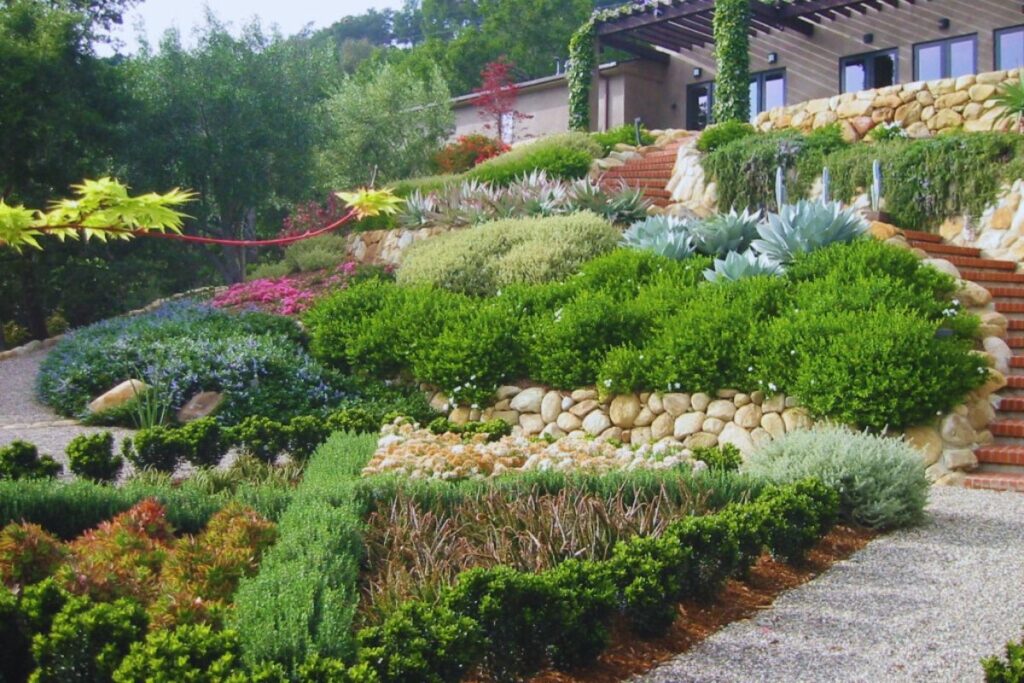Planting on hilly areas is difficult, Moisture levels can be seen in hilly areas. Also, not every plant can survive in hilly regions. It’s important to choose the plants smartly according to the soil type available and weather conditions. Hilly region has high moisture content in the environments so plant selection plays important role in the growth of species on a sloped landscape.
As the Erosion Level goes higher the slope rises. Yards that have slopes go better than 10%. Then you may go for retaining walls.. Plants that have dense, fibrous root systems may go well with this area. You can mix up variety and implement diverse variety. Don’t neglect sun heat for plants to ensure about 6 hours of sunlight for plants. Select perennials and shrubs that will live in winter or survive in shady and cold weather.
Following are some kinds of plants you can look into this and go through in details:-
- Catmint
- Creeping Juniper
- Russian Sage
- Sedge
- Liriope
- Cotoneaster
- Groundcover Roses
- Ajuga
- Deutzia
- Honeysuckle
Let’s read about the above plants
1. Catmint
Catmint is the most beautiful plant that is loved by butterflies and bees. They are hard perennials with attractive purple flowers. These plants carry long durability and survive for many months. This kind of flowers requires proper sun and heat. And go for the variety ‘Cat’s Meow’. This strongly influences the pollinators. These are best options for the sloped patterns
2. Creeping Juniper
The junipers that grow low delegate horizontally along the ground and in their settlement they require less maintenance and care. Their color changes from greenish to blue-green, throughout the whole year-round. The best variety for junipers is ‘Blue Chip’ which gives a vibrant appearance to your garden and looks more appetizing. They require a good amount of sun to grow and survive. These junipers goes very well with hilly areas.
3. Russian Sage
Russian sage plants transform from lacy blue-green foliage and also charm purple flowers that can stay for a large number of weeks. They have the power to attract hummingbirds and don’t require much water. They can survive well in drought areas. Go for the variety like ‘Denim ‘N Lace’. Russian sage needs full sun to survive.
4. Sedge
Sedges are versatile perennials that have diverse perennials and come in different colors and vibrant appearance, ranging from variegated to grassy-looking. It can survive in different soil textures, and once they are established, they can tolerate drought. Sedge can survive in partial sun but also survive in little shade. They are leafy and light yellow from the middle and greenish from the corners.
5. Liriope
Liriope, known as lilyturf, are perennials and look grassy. Despite their grass-like appearance, they are not grass. They present purple flower spikes during the spring season, and they have fast growth. They can survive in both shady and sunny conditions.
6. Cotoneaster
Cotoneasters are low-growing shrubs that produce baby white flowers; later, they will change into berries of red color. Also immediately spread around the ground. They have sprawling branches. If you want fast coverage of the area, then this is an excellent choice that goes well with hillsides, which require full sun.
7. Groundcover Roses
Landscape roses give an attractive look, and they are the best option for gentle slopes. They do coverage at a higher rate, require less maintenance and cutting, and throughout the season they grow and blossom in vibrant, bright flowers. Go for the species like ‘Drift; this is the recommended groundcover’. Don’t forget that all require proper and full sun.

8. Ajuga
Let’s move to the variety Ajuga that have a hard texture, and their ground cover has green or bronze leaves. In spring, flowers of purple color appear. They have fast-spreading capabilities and require some shade or heat. You can go with the variety Chocolate Chip.’
9. Deutzia
Deutzia is a low-growing shrub that carries a nice, mounded shape. They appear as beautiful pink bell-shaped flowers in spring. Its stunning form makes it eye-catching and attractive any time of year. Go for the varieties like ‘Yuki Cherry Blossom.’ Deutzia grows in the full sun.
10. Honeysuckle
Honeysuckle is the visible vine, which generally grows on a trellis and also creates beautiful ground cover. They have very nice-smelling flowers that can easily attract the hummingbirds. They have the feature of blooming late in the spring and early in the summer, and in the fall they give off red berries. Prefer a variety such as ‘Scentsation. For their better growth, they require sufficient sun.
Frequently Asked Questions
What are the benefits of planting on a sloped landscape?
The benefits of planting on sloped landscapes can help prevent erosion, enhance the beauty of the area, and give livelihood to wildlife. It also permits efficient water drainage and the use of space. These benefits integrates the looks of the place.
How can we choose the appropriate plants for a sloped landscape?
When selecting plants, it’s important to choose the plants wisely according to the type of soil available and the weather conditions. Go for plants that have dense, fibrous root systems because they play an important role in stabilizing the soil and preventing erosion.
Name some low-maintenance plant options for a sloped landscape.
Plants such as creeping juniper, liriope, honeysuckle, and groundcover roses are the best low-maintenance plant options for sloped landscapes. They require less maintenance, minimal cutting, and care once they grow, making them the best option for areas prone to erosion.
How can we prevent erosion on a sloped landscape?
By covering plants with spreading root systems, introducing retaining walls, and implementing the elements that can remove or avoid erosion, You can plant native plants that can survive in the local climate and improve soil stability.
Name some plants that can attract wildlife to a sloped landscape.
Plants such as honeysuckle, which is known for its fragrance, as well as ajuga and catmint, can attract butterflies and bees with vibrant color pops. These plants goes best with the sloped landscape.
How do I ensure proper sunlight exposure for plants on a sloped landscape?
It’s important to decide before how sunlight works throughout the day or for a long time plan according to that situation. Also, go for plants that can also be cold-tolerant.
Can I incorporate edible plants into a sloped landscape?
Yes, many edible plants, such as herbs, vegetables, and fruit-bearing shrubs, can be incorporated into a sloped landscape. Consider planting them in terraced beds or using retaining walls to create level planting areas and prevent soil erosion.
What kind of maintenance is required for plants on a sloped landscape?
Proper watering, mulching and timely pruning may be important for maintaining the health and visual appearance of plants on a sloped landscape. Analyze the soil erosion and drainage system properly.
The Conclusion
Selecting the right plants for a sloped landscape can be difficult because of factors like erosion, humidity levels, and sunlight requirements. It’s important to select the plant wisely that can grow and bloom in these conditions and supports to get rid of soil erosion, enhance the beauty of the landscape, and make it look mesmerizing. Growth of the plants are totally depend upon environment factors.
You must choose plants that have good density, and fibrous root systems are best for sloped areas. It gives great stability and prevents erosion. You can also go with a variety of perennials and shrubs that can go well in cold or winter season or icy environments and give you long-term results.
Stay tuned with us for more ideas!!
Read More:
How To Create A Balcony Garden: 8 Ideas for Small Spaces
How To Landscape with Rocks and Stones in Our Yards

